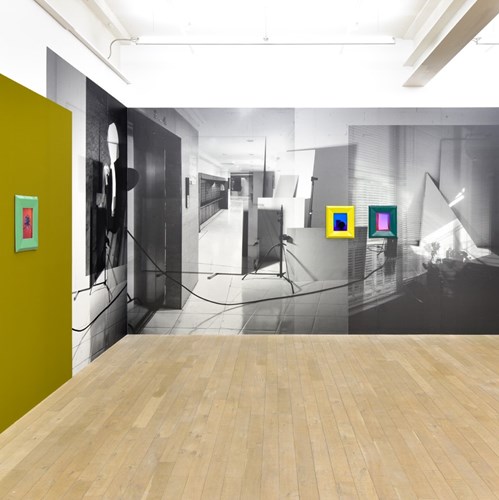Galerie Peter Kilchmann is pleased to present the third exhibition of Shirana Shahbazi (*1974 in Tehran; lives and works in Zurich) at the gallery. Shahbazi's conceptual practice in the medium of photography is characterized by a variety of production processes, at the beginning and end of which there is often the question of the reception of pictorial reality. In her new group of works, this question becomes the central driving force and guiding principle through the merging of various subjects and techniques of analog photography, such as the superimposition of pictorial levels using spatial installations in the studio. On display will be works in large, medium and small format.//
One of Shirana's many strengths is her ability to combine her motifs, colors, and production processes to create a contiguity of different realities. In her new exhibition, the artist follows this idea more than ever before: spatially and temporally shifted motifs are newly associated and merge with light and color to create a reality of complex ambiguity. The special creative phase that preceded the group of works was marked not least by the isolation and deceleration during the lockdown triggered at the beginning of April. A planned trip of the artist to her home town Tehran had to be canceled. The creative flow that arises from the exchange and encounter with people and places, which plays an important role in Shahbazi's work, did not materialize. Instead, the artist relied on the location of the studio, where she developed a new conceptual setting by bringing together her photographs of different places and subjects from nature/architecture, still life, landscape, and geometric abstraction known from her earlier series:
Like an architectural collage, the artist created a photographic backdrop of overlapping image planes. Existing photographs, test prints, and props were placed in front of colored documents and staged anew through different techniques of exposure. Monochrome color surfaces correlate with narrative pictorial elements, while colored light sources from different angles are superimposed on the composition. The shadow of the projection surface can be recognized as a dark bar in some of the pictures and gives the viewer a subtle insight into the analogous process of creation, which was deliberately left uncommented in past works. In some works the black surface takes on a very present role and seems to break up the space in a certain way. At the same time, it reveals details about the placement of the layered picture planes. The strong colors and sharp contrasts characteristic of Shahbazi become a muted, heavy luminosity. Traffic red and bright pink are replaced by tones such as midnight blue, purple, and moss green, which are only occasionally interrupted by glaring light reflections.
While the large-format works show more architectural elements, in the smaller works one encounters abstracted objects, flowers and landscape details. Occasionally the works show empty geometric forms or loosely arranged sheets of paper that seem to float in the colored space. They are almost painterly pictorial spaces, although their "emptiness" takes on a new level of meaning against the background of the lockdown, of "not being able to move".
The superimposition and association of pictorial spaces also occupy a fundamental part of Shahbazi's work in the architectural sense. As in past projects, e. g. at the Kunsthaus Hamburg (2018), the Kunsthalle Bern (2014) or the Museum of Modern Art, New York (2012), the artist will include the walls of the gallery spaces in her exhibition. The walls will be painted extensively with colors and form an installation frame for the hanging studio photographs. Both exhibition rooms will also feature a printed wallpaper, which, with monumentally enlarged motifs from Tehran, suggests a kind of cinematic backdrop. The motifs are a combination of photographs taken by the artist's mother and herself. Shahbazi thus creates a complex encounter, and thus an artificially staged simultaneity, temporally and spatially shifted moments, namely the archived moment, the moment in the studio, and finally the moment of individual perception by the viewer in the exhibition space. The result is a mixture of documentation and fiction that encourages the viewer to reflect on the reality of the image, identity, and the photographic staging.

